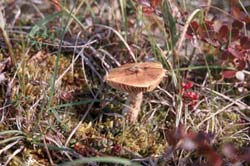New Method Confirms Importance of Fungi in Arctic Nitrogen Cycle

Cortinarius favrei grows in the midst of dwarf Betula and Salix, Vaccinium, and Eriophorum in the Alaskan tundra. At the Arctic LTER site, isotopic measurements indicate that mycorrhizal fungi function similar to this species contribute 60-90% of their plant’s nitrogen.
Technique Could be Applied to All Nitrogen-Poor Ecosystems
A new method to calculate the transfer of nitrogen from Arctic mushrooms to plants is shedding light on how fungi living symbiotically on plant roots transfer vital nutrients to their hosts. The analytical technique, developed by John E. Hobbie, MBL Distinguished Scientist and co-director of the laboratory’s Ecosystems Center and his son, Erik A. Hobbie of the University of New Hampshire, may be applied to nearly all conifers, oaks, beeches, birch and shrubs such as blueberry and cranberry—all nitrogen-poor ecosystems—and will be an important tool for future studies of plant nitrogen supply.
It has long been known when soil nitrogen is in short supply, mycorrhizal fungi (those living symbiotically on the roots of plants) transfer nutrients to their host plants in exchange for plant sugars derived from photosynthesis, but the rates of transfer have never been quantified in the field. John and Erik Hobbie’s study, published in the April 2006 issue of the journal Ecology, quantifies the role of mycorrhizal fungi in nitrogen cycling for the first time through measurements of the natural abundance of nitrogen isotopes in soils, mushrooms and plants. The researchers tested their technique using data from the Arctic LTER (Long Term Ecological Research) site near Toolik Lake, Alaska, in the northern foothills of the Brooks Range.
Previous research has found that when mycorrhizal fungi in the soil take up nitrogen from the soil and transfer it to small trees and shrubs, the heavy nitrogen isotope, nitrogen-15, is reduced in abundance in the plants and enriched in the fungi. Using a mass balance approach, an accounting of material entering and leaving a system, the researchers quantified the transfer of nitrogen and found that 61-86% of the nitrogen in plants at the site entered through fungal symbionts,
“Previous studies at this Arctic site have found a large range of nitrogen isotope content in plants and attributed the range to plants tapping into several different sources of nitrogen in the soil,” says John Hobbie. “Our study indicates that the differences can be attributed mainly to the presence or absence of symbiotic mycorrhizal fungi.”
The researcher’s new technique is shedding light not only on the nitrogen cycle in arctic tundra ecosystems, but can be applied to other nitrogen-poor ecosystems. “In the future, studies of plant nitrogen supply in all nitrogen-poor ecosystems must include these important transfers between plants and fungi,” says Hobbie.
Media Contact
More Information:
http://www.mbl.eduAll latest news from the category: Ecology, The Environment and Conservation
This complex theme deals primarily with interactions between organisms and the environmental factors that impact them, but to a greater extent between individual inanimate environmental factors.
innovations-report offers informative reports and articles on topics such as climate protection, landscape conservation, ecological systems, wildlife and nature parks and ecosystem efficiency and balance.
Newest articles

Bringing bio-inspired robots to life
Nebraska researcher Eric Markvicka gets NSF CAREER Award to pursue manufacture of novel materials for soft robotics and stretchable electronics. Engineers are increasingly eager to develop robots that mimic the…

Bella moths use poison to attract mates
Scientists are closer to finding out how. Pyrrolizidine alkaloids are as bitter and toxic as they are hard to pronounce. They’re produced by several different types of plants and are…

AI tool creates ‘synthetic’ images of cells
…for enhanced microscopy analysis. Observing individual cells through microscopes can reveal a range of important cell biological phenomena that frequently play a role in human diseases, but the process of…





















